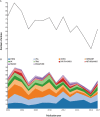Artificial liver research output and citations from 2004 to 2017: a bibliometric analysis
- PMID: 30647995
- PMCID: PMC6330953
- DOI: 10.7717/peerj.6178
Artificial liver research output and citations from 2004 to 2017: a bibliometric analysis
Abstract
Background: Researches on artificial livers greatly contribute to the clinical treatments for liver failure. This study aimed to evaluate the research output of artificial livers and citations from 2004 to 2017 through a bibliometric analysis.
Methods: A list of included articles on artificial livers were generated after a comprehensive search of the Web of Science Core Collection (from 2004 to 2017) with the following basic information: number of publications, citations, publication year, country of origin, authors and authorship, funding source, journals, institutions, keywords, and research area.
Results: A total of 968 included articles ranged from 47 citations to 394 citations with a fluctuation. The publications were distributed in 12 countries, led by China (n = 212) and the US (n = 207). There were strong correlations of the number of citations with authors (r 2 = 0.133, p < 0.001), and countries (r 2 = 0.275, p < 0.001), while no correlations of the number of citations with the years since publication (r 2 = 0.016, p = 0.216), and funding (r 2 < 0.001, p = 0.770) were identified. Keyword analysis demonstrated that with the specific change of "acute liver failure," decrease in "bioartificial livers" and "hepatocyte," and increase in "tissue engineering" were identified. The top 53 cited keyword and keyword plus (including some duplicates counts) were identified, led by bioartificial liver (405 citations) and hepatocyte (248 citations). The top 50 cited keywords bursts were mainly "Blood" (2004-2008), "hepatocyte like cell" (2008-2015), and "tissue engineering" (2014-2017). All keywords could be classified into four categories: bioartificial livers (57.40%), blood purification (25.00%), clinical (14.81%), and other artificial organs (2.78%).
Discussion: This study shows the process and tendency of artificial liver research with a comprehensive analysis on artificial livers. However, although it seems that the future of artificial livers seems brighter for hepatocyte transplantation, the systems of artificial livers now are inclined on focusing on blood purification, plasma exchange, etc.
Keywords: Artificial livers; Bibliometric analysis; Citations; Keyword.
Conflict of interest statement
The authors declare that they have no competing interests.
Figures






Similar articles
-
A Bibliometric Analysis of 100 Most-Cited Articles on Corneal Cross-Linking.Front Med (Lausanne). 2022 Jun 1;9:904077. doi: 10.3389/fmed.2022.904077. eCollection 2022. Front Med (Lausanne). 2022. PMID: 35721090 Free PMC article.
-
Bibliometric analysis of the top-cited gastroenterology and hepatology articles.BMJ Open. 2016 Feb 8;6(2):e009889. doi: 10.1136/bmjopen-2015-009889. BMJ Open. 2016. PMID: 26857105 Free PMC article.
-
A Bibliometric Analysis of the Most Cited Articles in Neurocritical Care Research.Neurocrit Care. 2019 Oct;31(2):365-372. doi: 10.1007/s12028-019-00731-6. Neurocrit Care. 2019. PMID: 31087256 Review.
-
A Bibliometric Evaluation of the Top 100 Cited Dimethyl Fumarate Articles.Molecules. 2021 Feb 19;26(4):1085. doi: 10.3390/molecules26041085. Molecules. 2021. PMID: 33669498 Free PMC article.
-
A bibliometric analysis of the top 100 most-cited case reports and case series in Endodontic journals.Int Endod J. 2022 Mar;55(3):185-218. doi: 10.1111/iej.13668. Epub 2021 Dec 9. Int Endod J. 2022. PMID: 34817068 Review.
Cited by
-
Status Quo and Research Trends of Neurosurgical Departments in China: Bibliometric and Scientometric Analyses.J Med Internet Res. 2021 Jul 5;23(7):e25700. doi: 10.2196/25700. J Med Internet Res. 2021. PMID: 36260378 Free PMC article.
-
Phytoremediation of Heavy Metal Pollution: A Bibliometric and Scientometric Analysis from 1989 to 2018.Int J Environ Res Public Health. 2019 Nov 27;16(23):4755. doi: 10.3390/ijerph16234755. Int J Environ Res Public Health. 2019. PMID: 31783655 Free PMC article.
References
-
- Aoki T, Koizumi T, Kobayashi Y, Yasuda D, Izumida Y, Jin Z, Nishino N, Shimizu Y, Kato H, Murai N, Niiya T, Enami Y, Mitamura K, Yamamoto T, Kusano M. A novel method of cryopreservation of rat and human hepatocytes by using encapsulation technique and possible use for cell transplantation. Cell Transplantation. 2005;14(9):609–620. doi: 10.3727/000000005783982710. - DOI - PubMed
-
- Arai K, Yoshida T, Okabe M, Goto M, Mir TA, Soko C, Tsukamoto Y, Akaike T, Nikaido T, Zhou K, Nakamura M. Fabrication of 3D-culture platform with sandwich architecture for preserving liver-specific functions of hepatocytes using 3D bioprinter. Journal of Biomedical Materials Research Part A. 2017;105(6):1583–1592. doi: 10.1002/jbm.a.35905. - DOI - PubMed
LinkOut - more resources
Full Text Sources

